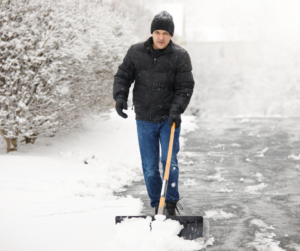This is Why Shoveling Snow Can Be So Dangerous
February 4, 2025
 For many people living here in the Utica area, shoveling snow is a routine winter chore. The thing people may not know, however, is this seemingly simple task can carry significant health risks.
For many people living here in the Utica area, shoveling snow is a routine winter chore. The thing people may not know, however, is this seemingly simple task can carry significant health risks.
This is true especially for those who are unprepared, out of shape, or unaware of the potential dangers (which we will mention below). Every year, thousands of individuals suffer injuries—or even fatalities—while clearing driveways and sidewalks.
Understanding these risks can help prevent accidents and ensure safety during our long Central New York winter months.
Increased Risk of Heart Attacks
Many of us know of someone or even have had a family member who has had a heart attack shoveling snow. So why is it dangerous?
One reason is simply the cold. The combination of cold temperatures and intense physical exertion can put immense strain on the cardiovascular system. Cold air causes blood vessels to constrict, increasing blood pressure and reducing oxygen flow to the heart.
At the same time, lifting and throwing heavy snow requires sudden bursts of energy, which can lead to cardiac arrest—especially for individuals with pre existing heart conditions.
Studies have shown that heart attack rates spike after heavy snowfalls, particularly among middle-aged and older adults. Those with high blood pressure, high cholesterol, or a history of heart disease should be particularly cautious.
To minimize the risk, it’s recommended that you take frequent breaks, push rather than lift the snow when possible, and avoid shoveling immediately after waking up when blood pressure is naturally higher.
Back and Muscle Injuries
Shoveling snow is a physically demanding activity that can lead to serious musculoskeletal injuries. Many people underestimate the strain it puts on the back, shoulders, and arms.
The repetitive motion of lifting heavy snow, twisting the torso, and throwing it aside can easily result in muscle strains, sprains, or even more severe conditions such as herniated discs.
Improper shoveling techniques further increase the risk of injury. People often bend at the waist instead of using their legs to lift, placing undue pressure on the lower back.
To prevent injuries, experts recommend using an ergonomic shovel with a curved handle, lifting small amounts of snow at a time, and avoiding sudden jerky movements. Stretching before and after shoveling can also help keep muscles flexible and reduce strain.
Slips, Falls, and Head Injuries
Snow and ice make for hazardous conditions, increasing the risk of slips and falls. Icy surfaces, hidden patches of black ice, or even just uneven piles of snow can cause a person to lose balance and suffer serious injuries. Falls can result in fractures, concussions, or even traumatic brain injuries, particularly among older adults.
To reduce the likelihood of slipping, wearing proper footwear with good traction is essential. Additionally, using salt or sand on walkways before shoveling can help improve grip and stability. Moving carefully and being aware of the surroundings can also prevent dangerous falls.
Shoveling snow is often seen as an unavoidable winter task, but it carries real risks that should not be ignored. Heart attacks, muscle injuries, and falls can turn a routine activity into a life-threatening event.
By using proper techniques, dressing appropriately, and being mindful of physical limitations, individuals can reduce the dangers associated with snow shoveling and stay safe during the winter season.
Until next time,
Your SZW Team
SZW Insurance is your Utica area Trusted Choice™ independent insurance agent. Call us for a quote on insurance for your home, car, business, or life at 315.792.0000. Or request a quote here.



